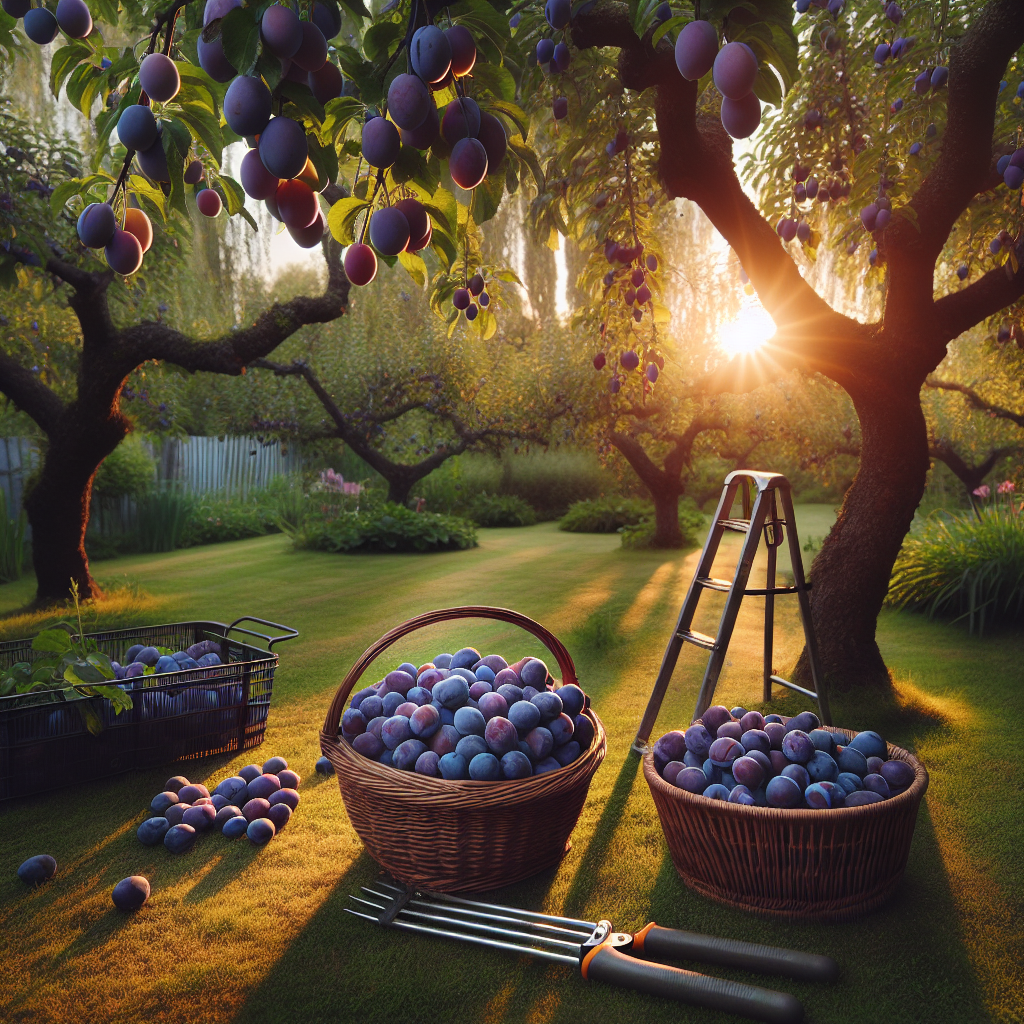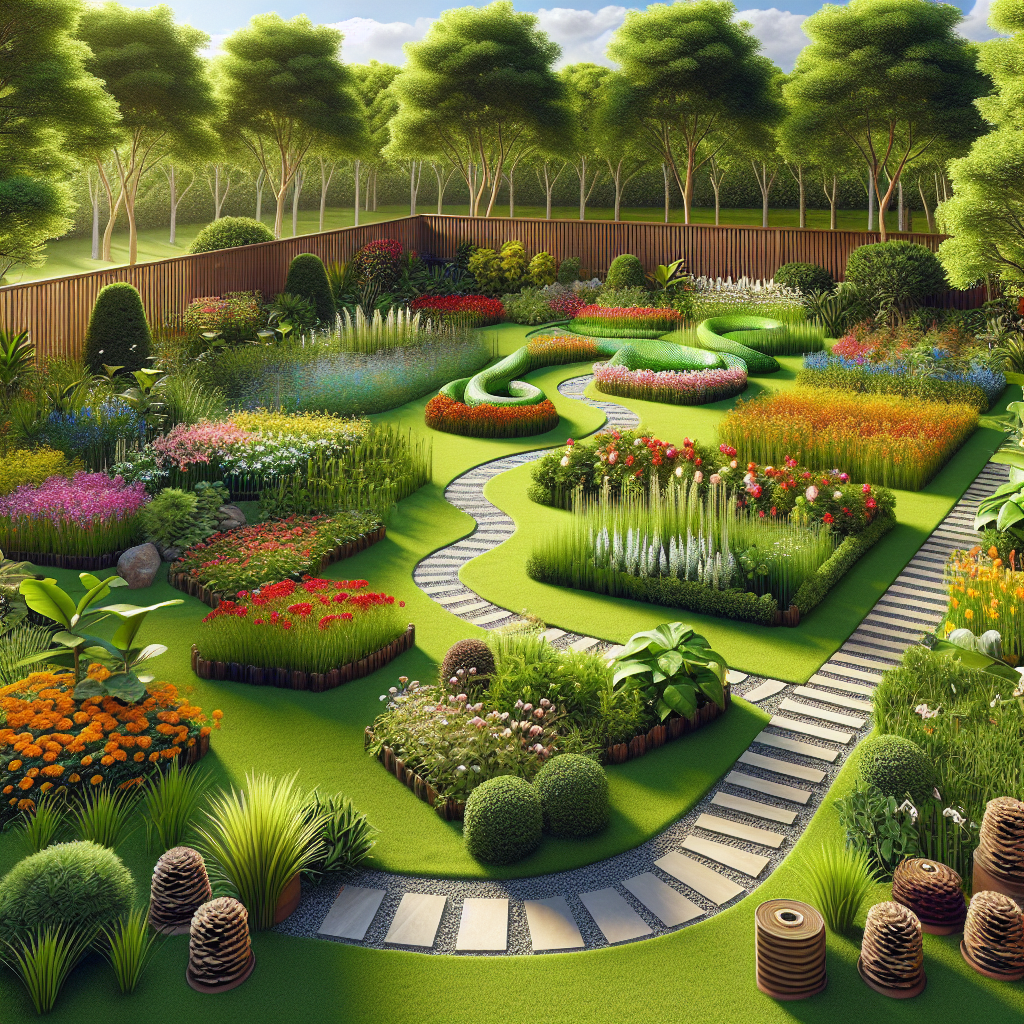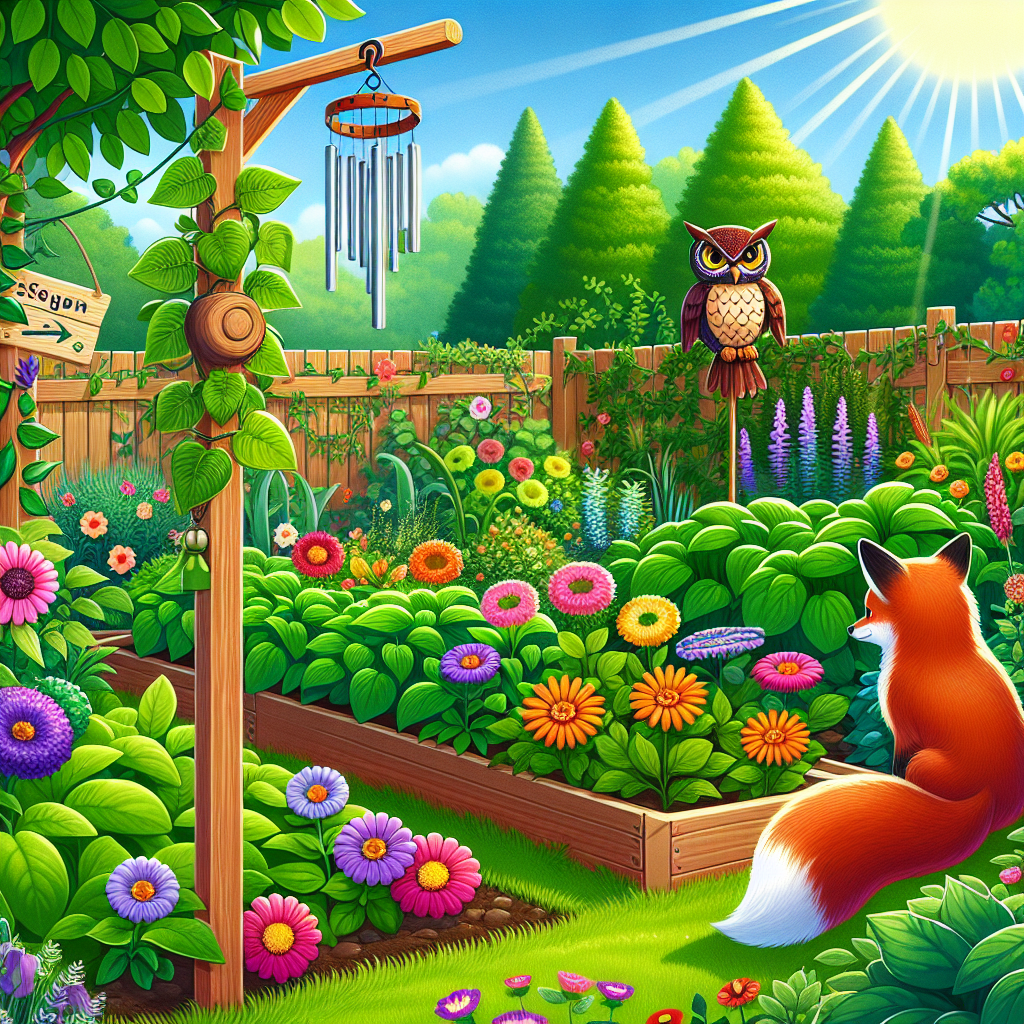Harvesting Techniques for Home-Grown Plums
Updated July 3, 2024 at 8:18 pm

- Pet FriendlyPlums are generally non-toxic to pets, but as with any human food, they should be given to animals in moderation.
- Light RequirementsPlum trees thrive in full sunlight, needing at least 6 hours of sun per day for optimal growth.
- WateringYoung trees require regular watering to establish roots, while established trees need more water as fruit sets and less as it ripens.
- HumidityWhile plums are adaptable, they don’t favor high humidity conditions that can promote fungal diseases.
- TemperaturePlum trees prefer moderate to warm temperatures and are hardy to USDA zones 5-9.
- DifficultyWith proper care and suitable conditions, plums can be moderately easy to grow for home gardeners.
Optimal Timing for Plum Harvest
Knowing when to harvest your plums is pivotal for achieving the best taste and quality. The timing largely depends on the specific variety of plum you have grown.
For many plums, the skin color may appear ripe before they are truly ready to harvest, so gently squeeze the fruit. If the flesh feels soft, and the fruit easily comes away from the branch, it is likely ready to pick.
Pre-Harvest Plum Tree Care
Before you even begin to think about harvesting, optimal tree care throughout the growing season can greatly affect your plum yield.
This includes regular pruning to maintain a healthy tree structure, thinning of fruits to prevent overburdening branches, and pest control to ensure plums remain unblemished and healthy.
Harvesting Tools and Techniques
Now, let’s talk about harvesting your plums. A good pair of gardening gloves and a fruit picker tool can make the process easier and protect both you and the fruit from damage.
For trees that are too high, a Fruit Picker Basket or Telescoping Fruit Picker can be invaluable. These tools often come with a basket or a bag at the end of a pole, allowing you to gently twist the fruit off the tree without using a ladder.
Find This and More on Amazon
Step-by-Step Guide to Harvesting Plums
The first step to harvesting is to lightly hold the plum and gently twist it off the stem. If you have to pull hard, it likely needs more time on the tree.
Once picked, place plums in a padded bucket or basket. Avoid piling them high as the weight can bruise the fruit at the bottom.
Post-Harvest Handling of Plums
After harvesting, it’s crucial to handle your plums with care to maintain their quality. Sort through the plums and separate any with cuts or bruises, as these will spoil faster.
For the plums you plan to consume soon, consider placing them in a fruit bowl at room temperature. For longer storage, place them in the refrigerator to slow down the ripening process.
Storing and Preserving Your Harvest
If you have more plums than you can eat right away, there are several options for preserving them. Canning, freezing, and making jams or jellies are popular methods that can extend the enjoyment of your harvest year-round.
A Ball Canning Kit can be an excellent investment for those looking to preserve their plums. It generally includes all the basic tools needed for canning, along with instructions for beginners.
Find This and More on Amazon
Pruning for Optimal Plum Fruit Development
Regular pruning of plum trees is essential, not just to keep them looking great but also to encourage the growth of strong, fruitful branches. Pruning should be done in the late winter or early spring to prevent disease and to shape the tree for the upcoming season.
When pruning, be sure to remove any dead or diseased branches, as well as any that are crossing over others which can cause damage and increase the chance of disease. Always use clean, sharp tools to make clean cuts that heal quickly.
Fertilizing for a Bountiful Plum Crop
Fertilization is another key aspect of successful plum production. Your plum trees will benefit from a balanced fertilizer applied in the early spring just before flower buds bloom to give an additional boost of nutrients that will help in fruit development.
Be cautious with nitrogen-heavy fertilizers, though, as too much can promote leaf growth at the expense of fruit production. A soil test can tell you exactly which nutrients your soil may be lacking.
Natural Pest Control Methods
Pests can be a significant problem when growing plums, but using natural control methods and preventive measures can help ensure a healthy harvest. For example, hanging pheromone traps in your trees can capture harmful insects without the use of harsh chemicals.
Encouraging beneficial insects like ladybugs and lacewings can also help as they prey on common pests such as aphids that might otherwise damage your plum trees.
Ideal Soil Conditions for Plums
Soil condition is paramount for plum trees. They prefer well-draining, loamy soil that isn’t too heavy or clay-rich. A consistent pH of 6.0 to 6.5 is generally considered ideal for plum trees.
If your soil doesn’t drain well, consider planting your plum tree on a raised bed or incorporate compost and sand to improve the soil structure and drainage.
Thinning Plum Fruit for Better Quality
Thinning your plum fruit might seem counterproductive, but it is an essential step in ensuring the remaining fruits grow large and healthy. When your plum tree is overly abundant, removing some of the fruit can prevent branches from breaking under the weight and improve air circulation.
Generally, thin the fruit so that they’re spaced around 2-3 inches apart. This might be a meticulous task, but in the end, you’ll have a healthier tree and better-quality fruit.
Troubleshooting Common Issues with Plum Trees
If your plum trees are not flowering or fruiting as expected, it could be due to a variety of issues. Insufficient chilling hours, poor pollination, or nutrient deficiencies could be potential causes. Reflect on what your tree might be lacking and address the issue accordingly.
Similarly, if you notice curled or discolored leaves, this could indicate a pest problem or a disease like plum-leaf curl or shot-hole fungus. Early identification and treatment are essential to prevent the spread and ensure the health of your tree.
Using Mulch to Protect and Nourish Plum Trees
Mulching is a fantastic way to conserve soil moisture, maintain soil temperature, and suppress weeds. A layer of organic mulch like straw or wood chips can benefit your plum trees, especially in the heat of summer.
However, avoid piling mulch directly against the trunk as this can promote rot and provide a habitat for pests. Keep the mulch a few inches away from the base for the best results.
Creative Ways to Utilize Your Plum Harvest
Beyond eating them fresh, there are numerous creative ways to use your plum harvest. Have you considered making plum wine or crafting homemade plum vinegar? These projects can be both fulfilling and delicious.
Plum-infused spirits or creating a plum barbecue sauce are also unique ways to enjoy your fruit and impress your family and friends with your culinary creativity.
Sharing Your Plum Bounty
If you find yourself with a surplus of plums, sharing your harvest with friends, family, or local food banks can spread joy and reduce waste. Plums make excellent gifts, especially when presented in a basket or as part of a homemade fruit arrangement.
Engaging with community food-sharing programs is another wonderful way to make the most out of your plum bounty and support those in need.
Reflecting on Your Plum Harvesting Experience
Harvesting home-grown plums can be incredibly rewarding. Not only do you get to enjoy the delicious fruits of your labor, but you also gain valuable gardening experience and knowledge with each passing season.
Take the time to reflect on what worked well and what can be improved for next year’s harvest. Gardening, after all, is a continuous learning journey!
Community and Online Resources for Plum Growers
Don’t forget, you’re not alone in your plum-growing endeavors. Local gardening clubs and online forums can be great resources for advice and support. Connecting with fellow plum enthusiasts can provide a wealth of information and encouragement.
Consider joining online groups dedicated to fruit gardening or visit your local cooperative extension office for region-specific advice and workshops on fruit tree care.
The Joy of Growing Plums at Home
Ultimately, growing plums at home is about the joy of nurturing a living thing and watching it flourish under your care. Each plum is a little success story, a tangible result of your efforts and dedication over the seasons.
Celebrate each harvest, big or small, and continue to find happiness in the simple pleasure of gardening. Remember that with each tree you grow, you’re not only enriching your life but also contributing to the environment and the well-being of your community.
Making the Most of Your Growing Space
If your growing space is limited, consider training your plum trees using methods such as espalier or fan training. These techniques not only save space but can also make harvesting easier and improve air circulation, which reduces the risk of diseases.
For those with larger plots, diversifying with different varieties of plums can extend the harvesting season and provide a variety of flavors and uses for your plums, from eating fresh to preserving.
Eco-Friendly Practices for Sustainable Plum Production
Implementing eco-friendly practices in your plum orchard is not only good for the environment but can also yield healthier fruits and potentially increase the biodiversity of your garden.
Conserving water through drip irrigation systems, using organic mulches, and practicing crop rotation are just a few sustainable methods that can enhance your plum growing experience.
Benefits of Eating Home-Grown Plums
Eating home-grown plums has numerous benefits, including the richness in vitamins and antioxidants which contribute to your overall health. Moreover, you have the assurance of the fruit’s quality and the absence of harmful pesticides typically associated with store-bought fruits.
Plus, the satisfaction of eating something you’ve grown yourself is unmatched. It’s a simple pleasure that comes with the pride of your gardening accomplishments.
Overcoming Challenges in Plum Gardening
While plum gardening can be very fulfilling, it’s not without its challenges. Weather events, such as late frosts or prolonged drought, can impact your harvest. Learning how to adapt and mitigate these challenges is part of becoming a successful home gardener.
Investing in protective measures, like frost cloths during a sudden cold snap or shade nets during scorching heatwaves, can help protect your crop and ensure that you don’t lose all your hard work to unpredictable weather.
The Rewards of Patience in Plum Cultivation
Patience is a virtue, especially in the garden. Plums take several years to begin producing fruit, and even then, the first few harvests may be small. But with time and dedication, your tree will start bearing more fruit.
Enjoy the journey as much as the destination, and remember, the wait makes the reward – a bountiful plum harvest – all the sweeter.
Continuous Learning and Adaptation
Gardening is a continual process of learning, adapting, and growing – much like the trees you tend. With each season comes new insights and a deeper understanding of your garden’s unique needs and rhythm.
Attend workshops, read up on the latest gardening techniques, and don’t be afraid to try new methods or products that might enhance your plum-growing experience.
Incorporating Plums into Your Healthy Lifestyle
Plums are more than just a tasty snack; they’re a versatile ingredient that can contribute to a healthy lifestyle. Add them to your morning oatmeal, blend them into smoothies, or use them in savory dishes for a natural sweetness.
Their fiber content aids in digestion, and their natural sugars provide a quick energy boost, making them an excellent addition to any diet.
Embracing the Community Spirit of Gardening
One of the greatest aspects of gardening is the sense of community it fosters. Share your successes, seek advice during setbacks, and exchange seeds or cuttings with neighbors to broaden the diversity of your garden.
Community gardens are also a great place to meet like-minded individuals and can be a resource for learning and sharing in the joy of growing your own food.
Final Thoughts on Enjoying Your Home-Grown Plums
As you savor the sweet, juicy flavor of your home-grown plums, remember to take pride in the hard work and care that brought them from blossoms to your table.
Each year, with every harvest, you’ll gain more knowledge and skills, ensuring that your plum trees continue to provide you with delightful fruits for many seasons to come.
Finding Further Information and Supplies
Inspired to start or improve your home orchard? Local nurseries, gardening centers, and online retailers are excellent places to find high-quality plum trees, tools, and other gardening supplies. Don’t hesitate to ask for recommendations or seek out reviews to find the best products to meet your needs.
Remember, investing in good tools and resources can make all the difference in the ease and success of your gardening ventures.
The Satisfaction of Growing Plums from Seed
If you’re up for a challenge, consider growing plums from seed. Although it takes longer to get fruit, and the outcome may be different from the parent plant, this can be an exciting project for the more patient and experimental gardener.
Seeing a tree grow from seed to fruit-bearing maturity is one of the most satisfying experiences for a gardening enthusiast.
Leaving a Legacy with Your Plum Trees
Lastly, think of your plum trees as a legacy you can leave behind. These hardy trees can live for decades, providing beauty, shade, and fruit for future generations to enjoy.
Each tree is a testament to your commitment to nurturing life and enriching the environment, making the world a little sweeter one plum at a time.
Shop more on Amazon

